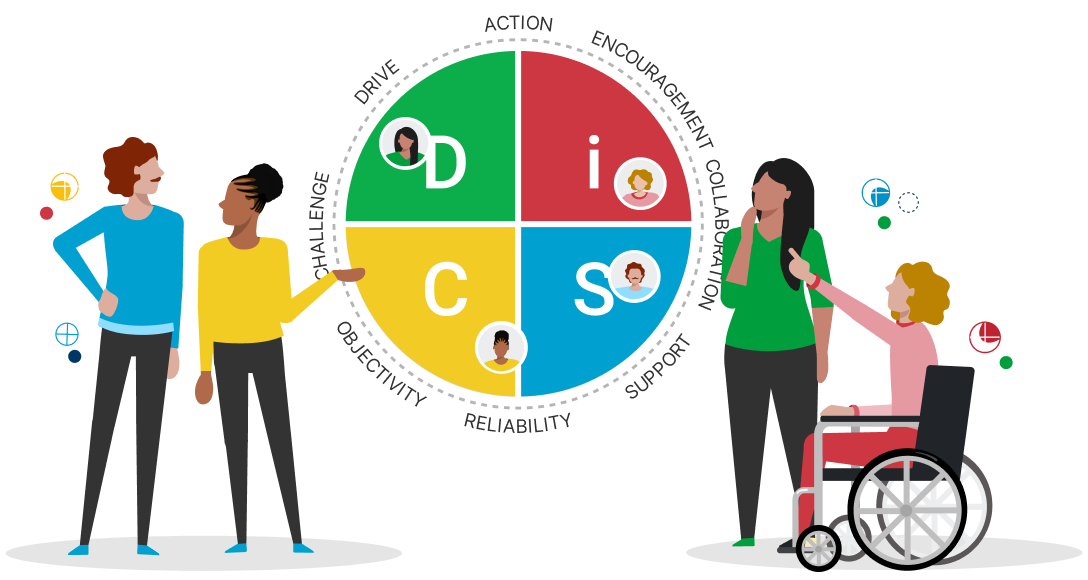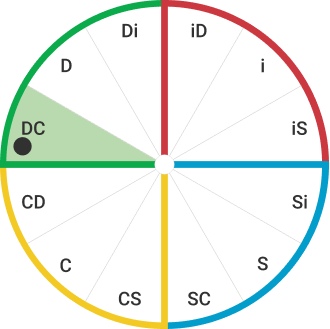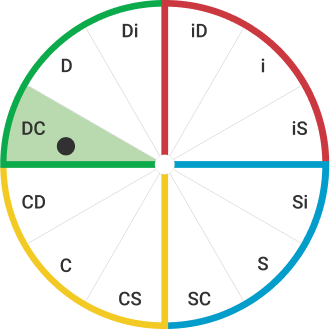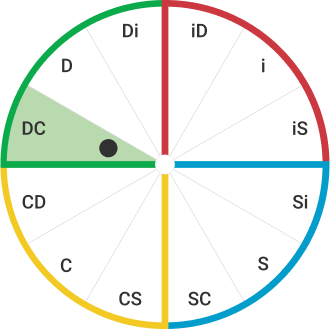How DiSC® Works
At Everything DiSC®, we’ve dedicated ourselves to making our DiSC® assessment and learning experience as intuitive and user-friendly as possible. This includes the visual representation of each individual’s assessment results within our proprietary DiSC map, also known as the DiSC circumplex. This map allows each learner to inherently recognize and understand themselves and how they relate to others in the workplace.
Dot Placement
A dot’s distance from the edge of the circle shows how naturally inclined a person is to encompass the characteristics of their DiSC style.
A dot positioned toward the edge of the circle indicates a strong inclination toward the characteristics of the style. A dot located between the edge and the center of the circle indicates a moderate inclination. Finally, a dot positioned close to the center of the circle indicates a slight inclination.
For example, someone whose dot placement is on the fringe of the DC portion of the map will likely strongly identify with and present most if not all the characteristics associated with the DC style—independent, difficult to read, skeptical—whereas someone whose DC dot placement is closer to the center of the map will only identify with and express some of these characteristics.
It is important to remember that a dot in the center of the circle is no better than one on the edge and vice versa.
Shading
While dot location and DiSC style say a great deal about a participant, map shading is also important.
The eight words around the Everything DiSC map are called priorities, or the primary areas where people focus their energy. The closer a participant’s shading comes to a priority, the more likely they are to focus their energy on that area.
Everyone has at least three priorities, and personalized shading indicates whether the participant stretches to include up to two additional priorities. These additional priorities are marked by striped shading, as shown in the image below.
Stretch
The continuous nature of the DiSC circle also helps people understand the idea of “stretch.” It is helpful to think of your style as your home base or comfort zone. As mentioned earlier, the Everything DiSC profiles use shading to help participants understand the areas on the DiSC map where they might have difficulty stretching.
To learn more about the concept of stretch for each style, click on each quadrant of the map below.
D Style Comfort Zone: Taking fast action towards achieving results
D Style Stretch Zone: Setting a timeline that accommodates everyone's needs
i Style Comfort Zone: Generating excitement around a new idea
i Style Stretch Zone: Conducting a careful analysis of a new idea
S Style Stretch Zone: Standing firm on an unpopular point of view
S Style Comfort Zone: Ensuring people feel included and accepted
C Style Stretch Zone: Taking action without all the facts
C Style Comfort Zone: Focusing on logic and facts to create accurate solutions
Generally, people with dots located close to the center usually have a somewhat easier time adopting foreign DiSC styles when the situation calls for it. People whose dots are on the edge of the circle may have to stretch more (and experience more stress) if they want to adopt another style. On the other hand, because these people have more pronounced DiSC styles, those styles are often accompanied by some very distinct strengths.
Relationships
One of the most powerful aspects of the DiSC circumplex is that it allows us to show the relationship between two people in a straightforward, visual manner.

For instance, imagine coworkers Mina, a D style, and Silas, an i style. Even though Mina and Silas both prioritize action and may share a tendency to be fast-paced and outspoken, they also differ dramatically. Mina tends to focus on results and challenges, so she’s likely to be questioning and skeptical of other ideas while also centered on the bottom line. Silas values enthusiasm and collaboration and may focus more on getting everyone involved and building team spirit. In this case, Mina can see how she and Silas complement each other and where they may share blind spots.
Although the line graph representation of DiSC allows us to compare the profile of two people, a great deal more interpretation is necessary before the implications of that comparison become clear. By plotting each individual's dot on the DiSC circumplex, people immediately see and understand their similarities and differences.
Solutions That Meet Your Unique Needs
People work together in a variety of contexts. No matter your specific need, Everything DiSC is designed to help everyone in your organization work better together—from individual contributors to C-suite executives.
*Available on the Catalyst™ platform


